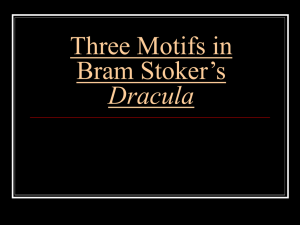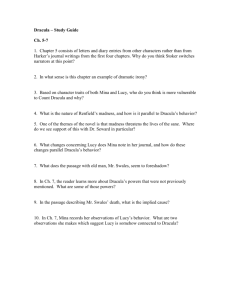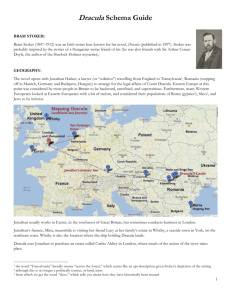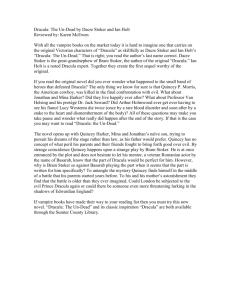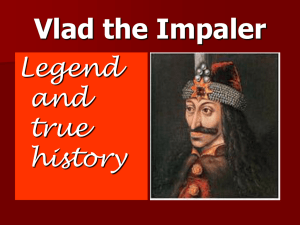Dracula Study Guide.pub
advertisement
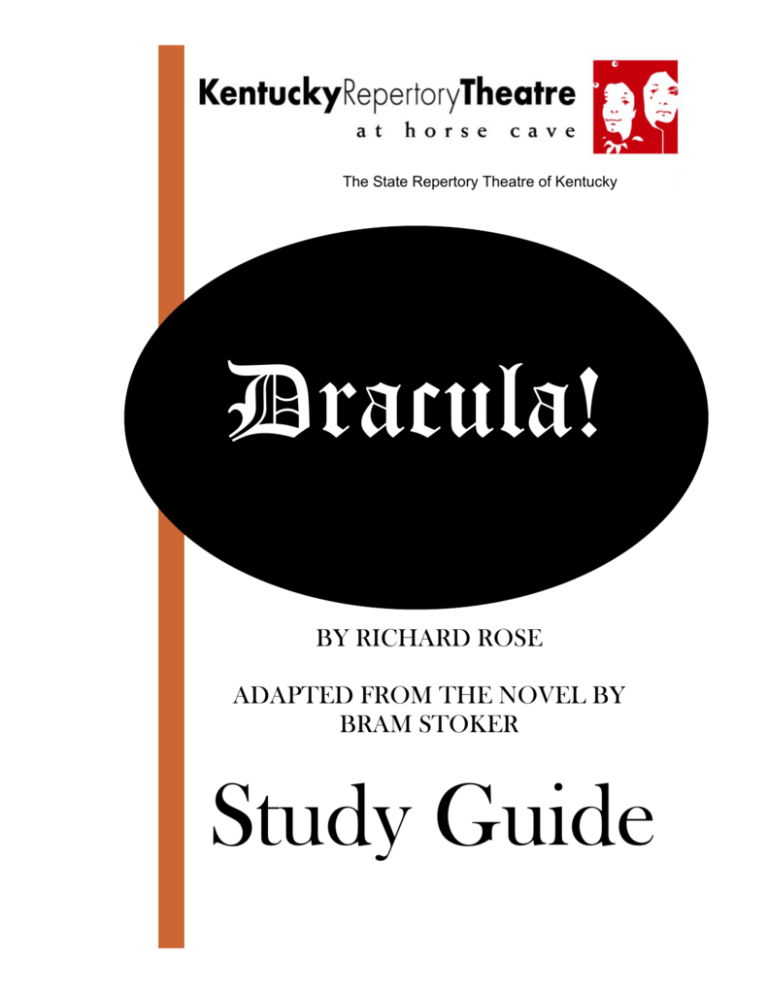
The State Repertory Theatre of Kentucky Dracula! BY RICHARD ROSE ADAPTED FROM THE NOVEL BY BRAM STOKER Study Guide Page 2 Dracula! Some say the victim’s blood is being drained, but there is no blood to be found. Some say the dead are walking. Dr. Seward summons his old friend Dr. Eva Van Helsing to help him solve this mystery. After seeing the patient, she knows this is no ordinary illness. The arrival of a stranger from Transylvania confirms her deepest fears of something darker. This is the classic story of horror and seduction based on Bram Stoker’s novel. WHICH KERA ACADEMIC EXPECTATIONS RELATE TO OUR PROGRAM? 1.3, 1.4, 1.13, 1.14, 1.15, 2.16, 2.23, 2.24, The Kentucky Arts Council, the state arts agency, supports Kentucky Repertory Theatre with tax dollars and federal funding from the National Endowment for the Arts. Page 3 Bram Stoker (1847-1912) Writer of one of the world’s most famous horror novels, Abraham Stoker was born to the loosely defined socio-cultural group known as the Anglo-Irish. A Protestant Dubliner, he was the son of a civil servant, and he was expected to follow in his father’s footsteps. As a child, Abraham Stoker was a sickly child often on the point of death. By his own account, he never stood upright without aid until he was seven years old. To entertain him, his mother used to tell him ghost stories. But he grew into a physically robust youth, excelling in athletics during his college years. At Trinity College, he studied mathematics and became president of the Philosophical Society and the Historical Society. In the years between 1870 and 1877, he was a civil servant at Dublin Castle. He maintained ties to Trinity College, returning there frequently to speak on a wide range of topics for the Philosophical Society. He was deeply interested in the romantic poets, and during these years he established a correspondence with Walt Whitman. The two men exchanged letters until Whitman’s death. Stoker also became an enthusiastic theatergoer and an ardent admirer and friend of the actor Henry Irving, writing dramatic criticism and glowing reviews of Irving’s works for the local papers. Many have argued that Henry Irving was an important model for the character of Count Dracula. . . . During these years, Stoker’s position in the Historical Society at Trinity put him in contact with Dublin’s elite. He became a regular guest of Sir William and Lady Wilde, the parents of Oscar Wilde, and was drawn into Lady Wilde’s literary and artistic circle of friends. He competed with Oscar Wilde for the hand of Florence Balcombe, a beautiful young actress who was the daughter of a lieutenant-colonel. Florence chose Bram, and the two were married in 1878, the same year he left for London and a new job as the business manager of Henry Irving’s Lyceum Theatre. . .. The many years with Henry Irving were full of hard work and sacrifice, as Stoker frequently put his work before his family. His only child, Noel, was born in 1879. Noel later felt that Stoker’s work for Irving wore out the devoted younger man. His duties included keeping track of more than 120 staff members, handling international tour arrangements, writing volumes of correspondence, balancing Lyceum’s books and protecting the wildly-admired actor from those who would exploit his fame. It was during these years that Stoker wrote his greatest novel, Dracula (1897). In 1905, Irving collapsed and died while on tour in Sheffield. Stoker was so profoundly affected by the death of his friend and hero that he suffered a stroke. After Irving’s death, Stoker continued to write fiction and do newspaper work until his own death in 1912. Bram Stoker wrote numerous novels, short stories, essays, and lectures, but Dracula is by far his most famous work. His other works have not aged well, but the story of Count Dracula continues to sell steadily even to this day. Stoker coined the term “undead” and his interpretation of vampire folklore has powerfully shaped depictions of the legendary monsters ever since. (Taken from: www.shakespearefest.org/dracula%20study%20guide.htm ) Page 4 Vlad Tepes: The Real Dracula Vlad Tepes (pronounced Tsepesh) was born in the town of Sighisoara in Transylvania (now known as northern Romania) in 1431 and later came to rule that area of southern Romania know as Wallachia. The word “tepes” in Romanian means “impaler” -- and Vlad was sonamed because of his penchant for impalement as a means of punishing his enemies. Impalement was a particularly gruesome form of execution, wherein the victim was impaled between the legs – to put it politely – upon a large, sharpened stake the width of a burly man’s arm. At the same time that Vlad became notorious for his sadism, he was also respected by his subjects because of his fierce campaigns against the Turks. He was respected as a warrior and stern ruler who tolerated no crime against his people, and during his reign erected several monasteries. However, despite Vlad’s political ambition, the turbulent political atmosphere of the times took its toll on his reign. He was overthrown twice (he ruled for a brief period in 1448, again from 1456-1462, and for only a matter of weeks in the year of his death, 1476). Ultimately, Vlad died violently (according to rumor, at the hands of one of his men who was actually a Turkish spy.) He was buried at one of the monasteries he patronized, on the island at Snagov. Contrary to popular belief, Dracula’s castle does not exist in Transylvania; the crumbling ruins still stand in the northern Wallachian town of Tirgoviste.* Origin of the Name “Dracula” King Sigismund of Hungary, who became the Holy Roman Emperor in 1410, founded a secret fraternal order of knights called the Order of the Dragon to uphold Christianity and defend the Empire against the Ottoman Turks. Its emblem was a dragon, wings extended, hanging on a cross. Vlad III’s father (Vlad II) was admitted to the Order around 1431 because of his bravery in fighting the Turks. From 1431 onward Vlad II wore the emblem of the order and later, as ruler of Wallachia, his coinage bore the dragon symbol. The word for dragon in Romanian is “drac” and “ul” is the definitive article. Vlad III’s father thus became to be known as “Vlad Dracul” or “Vlad the dragon.” In Romanian the ending “ulea” means “the son of.” Under this interpretation, Vlad III thus became Vlad Dracula, or “the son of the dragon.” (The word “drac” also means “devil” in Romanian. The nickname thus took on a double meaning for enemies of Vlad Tepes and his father.)* (Taken from: www.shakespearefest.org/dracula%20study%20guide.htm ) Page 5 Truly Horrifying Stories of Vlad the Impaler Vlad Dracula was a truly sadistic leader. Here are two stories that show his cruelty. They are taken from the site listed below where you can find more of these stories. (More gruesome than these two. Whether you want to share these with your students is up to your discretion.) The Burning of the Sick and the Poor Vlad Dracula was very concerned that all his subjects work and contribute to the common welfare. He once noticed that the poor, vagrants, beggars and cripples had become very numerous in his land. Consequently, he issued an invitation to all the poor and sick in Wallachia to come to Tirgoviste for a great feast, claiming that no one should go hungry in his land. As the poor and crippled arrived in the city they were ushered into a great hall where a fabulous feast was prepared for them. The guests ate and drank late into the night. Vlad himself then made an appearance and asked them, “What else do you desire? Do you want to be without cares, lacking nothing in this world?” When they responded positively Vlad ordered the hall boarded up and set on fire. None escaped the flames. Vlad explained his action to the boyars by claiming that he did this “in order that they represent no further burden to other men, and that no one will be poor in my realm.” The Foreign Ambassadors Although there are some discrepancies between the German and Russian pamphlets in the interpretation of this story, they agree to the following : Two ambassadors of a foreign power visited Vlad’s court at Tirgoviste. When in the presence of the prince, they refused to remove their hats. Vlad ordered that the hats be nailed to their head, such that they should never have to remove them again. Note: The nailing of hats to the heads of those who displeased a monarch was not an unknown act in eastern Europe and by the princes of Moscow. (All of the above is taken from: www.shakespearefest.org/dracula%20study%20guide.htm ) Page 6 CHARACTERISTICS OF THE VAMPIRE Here are the characteristics of Count Dracula as presented by Bram Stoker in his novel Dracula. Other writers, of course, have altered these to suit their own literary purposes. Count Dracula possesses the following powers and supernatural traits: He He He He He He He He He He He He is potentially immortal. survives on the blood of others. has the strength of twenty men. can shape-shift into the form of a wolf or a bat. can appear as mist or elemental dust. has no reflection in a mirror. casts no shadow. has hypnotic power over his victims. can turn victims into vampires. can direct the elements—storms, fog, thunder. can command the rat, the owl, the bat, the wolf, the fox, and the dog. can at times vanish and become unknown. But on the other hand, he does have limitations: He may not enter a household unless he is invited first. He loses his supernatural powers during the daylight hours. He must sleep on the soil of his native land. He can cross running water only at the slack or the flood of the tide. He is repelled by garlic and holy symbols (crucifix, holy wafer). He can be destroyed by driving a stake through his heart and decapitating him. Whatever form he is in at daylight, he will remain until sunset. He is rendered inactive by a wild rose. Compiled from: www.ucs.mun.ca/~emiller/traits.htm & a study guide from www.waysidetheatre.org Page 7 Internet searches www.draculascastle.com This is the site for one of Vlad Tepes’ castles—Bran Castle. It has pictures of Vlad Dracula, history and gives a tour with narration. It is not the original Castle Dracula, which is now in ruins, but is a castle used by him. www.aboutromania.com/dracula.html Gives photos of other castles associated with Vlad Tepes, along with pictures and drawing of him. The Kentucky Repertory Theatre’s production of Dracula! was adapted by Richard Rose. The original book by Bram Stoker is very different. Read Stoker’s novel. What are the differences between this play and the original novel? Write an essay discussing these differences and which version you prefer. Page 8 FREYTAG’S PYRAMID Try to plot Dracula according to Freytag’s Pyramid. Not every story can be broken down perfectly into this pyramid. Can Dracula? Fill out the pyramid. See how many different answers you get. Then, as a class, come up with a pyramid everyone agrees on. The class might not be able to agree with clear cut answers to this pyramid. Freytag’s Pyramid is divided into seven different parts. Climax Rising Action Falling Action Exposition Denouement Inciting Incident Resolution 1) Exposition-setting the scene. 2) Inciting Incident-single event that causes conflict. 3) Rising Action-the story builds. 4) Climax-the moment of greatest tension. 5) Falling Action-events that happen as result of climax. 6) Resolution-character solves the main conflict. 7) Denouement-(pronounced: day-noo-moh) the ending.
